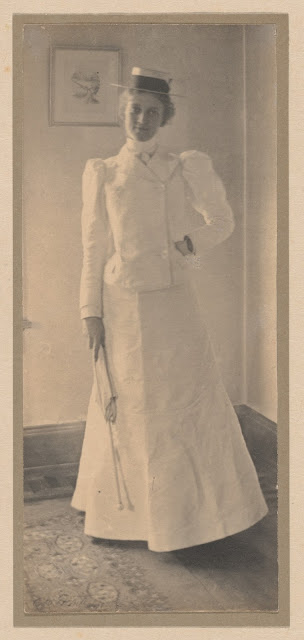 |
| Clarence H. White Baby Monsarrat 1905 platinum print Metropolitan Museum of Art, New York |
 |
| Clarence H. White Portrait of Mrs. H. 1898 platinum print Metropolitan Museum of Art, New York |
 |
| Clarence H. White The Bubble 1898, printed 1905 platinum print Metropolitan Museum of Art, New York |
"A self-taught photographer from rural Ohio, Clarence H. White (1871-1925) first became famous for his delicate, idealized images of rural family life. A charter member of the Photo-Secession in 1902, he was a frequent contributor to Camera Work and, after 1906, when he moved to New York, a member of Alfred Stieglitz's inner circle. Appointed the first photography instructor at Columbia University Teachers College in 1907, White also taught photography at the Brooklyn Institute of Arts and Science (now the Brooklyn Museum) for thirteen years. Purchasing a small cabin in Maine in 1910, he founded the Seguinland School of Photography, a summer school where well-known photographers such as F. Holland Day and Gertrude Käsebier supplemented White's gentle instruction with informal critiques. White continued to promote Pictorialism even after falling out with Stieglitz in 1910 over the latter's abandonment of the style in favor of a more modern direction."
– Maria Morris Hambourg and Audrey Sands, writing for the Museum of Modern Art, New York
 |
| Clarence H. White Coming through the door 1898 platinum print Metropolitan Museum of Art, New York |
 |
| Clarence H. White Morning - The Coverlet 1906 platinum print Metropolitan Museum of Art, New York |
 |
| Clarence H. White Torso 1907 platinum print Metropolitan Museum of Art, New York |
 |
| Clarence H. White Portrait of F, Holland Day with Male Nude 1902 platinum print Metropolitan Museum of Art, New York |
 |
| F. Holland Day The Vigil 1899 platinum print Metropolitan Museum of Art, New York |
"Fred Holland Day (1864-1933) was a wealthy eccentric and philanthropist from Massachusetts. As partner in the publishing firm Copeland and Day, which he founded in 1884, Day indulged his passion for English literature, publishing exquisite small-edition, hand-bound volumes by the likes of Dante Gabriel Rossetti and Day's friend Oscar Wilde. Although Copeland and Day published ninety-eight books and periodicals, the firm was never financially successful. Day began to photograph in 1886; he wrote extensively about photography's position as a fine art and organized international photography exhibitions to further his claim. . . . Day's photographs were controversial for the unconventional depiction of religious subject matter and for the male nudity he employed. His style was Pictorialist, and he favored platinum prints, which are distinguished by their fine detail and ability to render a full range of soft tones. He lost interest in photography when a shortage of platinum during World War I made printing prohibitively expensive and eventually impossible. He died twenty years later, in relative obscurity."
– biographical notes from the Getty Museum
 |
| F. Holland Day The Entombment 1898 platinum print Metropolitan Museum of Art, New York |
 |
| F. Holland Day Boy piping ca. 1896 platinum print Metropolitan Museum of Art, New York |
 |
| F. Holland Day Draped nude lounging in the grass ca. 1897 platinum print Metropolitan Museum of Art, New York |
 |
| F. Holland Day The Honey Gatherer ca. 1898 platinum print Metropolitan Museum of Art, New York |
 |
| F. Holland Day An Ethiopian Chief ca. 1897 platinum print Metropolitan Museum of Art, New York |
 |
| F. Holland Day Ebony and Ivory ca. 1897 platinum print Metropolitan Museum of Art, New York |
 |
| F. Holland Day Zaida Ben Yusuf 1898 platinum print Metropolitan Museum of Art, New York |